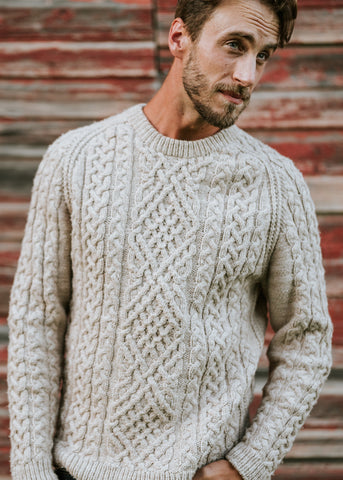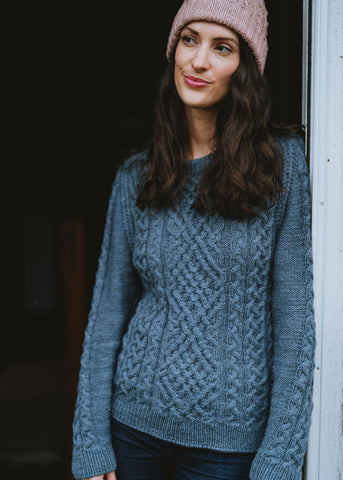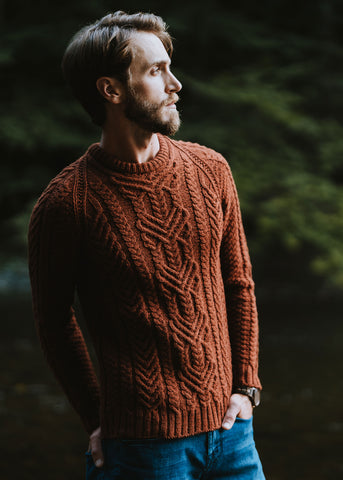Sweater Season: Swatching for Sweaters

[Emily Greene's Fall Creek, from Spring 2020]
Okay, we admit it: we're both die-hard sweater knitters, and we think pretty much any time of the year is sweater season. But, both of us have a penchant for starting new projects in this after-holiday time, as a moment to reflect and start to focus on something a little longer-term after our frenzied needles knit gifts for friends and relatives. It's still deep enough in the winter that there's plenty of time to wear the FO, and we're able to imbue it with hopes, dreams, and plans for the year ahead. As we've been working on sweaters for our upcoming Deep Winter collection, we've been thinking about some of our favorite sweater knitting tips and tricks from now, well, a lot of years and a lot of sweaters. We'll be sharing them with you over the next few weeks, in the hopes that some of them may help your first sweater projects of 2021, whether they're your first sweaters or your hundredth. See the full series here. Looking for an H+W sweater to start your year off right? Find the full set here.
Swatching for Sweater Knitting
I know, I know: you heard the word "swatch," and you're groaning already. But, bear with me. As I have told all of my sweater-knitting students over the years, there are two kinds of successful sweater knitters: planners and froggers.
I personally hate frogging, and am willing to do quite a lot of planning to avoid it. So, that's my personal bias, and a lot of my sweater-knitting tips and tricks are really about improving this planning phase of the process so that the sweater we end up with at the end is as close as possible to the one we envisioned when we set out. And swatching — predictive, useful swatching — is a key part of that process.
So, how do we make a good swatch? We need to accurately simulate the knitting conditions that we're likely to face for this particular sweater. This means:
- We need to cast on enough stitches to mimic the physical experience of knitting the large pieces involved in a sweater. This usually means somewhere between 36 and 46 stitches, for most people. Small-object knitting is just a physically different enterprise, and we need to experience the weight and tension of a bigger piece.
- We need to knit enough vertical distance to see the stitch pattern emerge, and to get an accurate measurement. This is usually 5-6" of vertical distance.
- We need to knit in approximately similar conditions to the conditions we'll knit the sweater in. Literally. The same needles, the same techniques, the same basic environment. I once knit half a sweater in a series of dark bars in Times Square during Vogue Knitting Live; the swatch I did in my brightly-lit office was not very predictive.
- We need to block our swatches the way we block our sweaters. If you're using Forge or Weld, we recommend that this means a dip in a bath of lukewarm water and old-fashioned dish soap, followed by a gentle rinse. If you plan to pin your sweater out, pin your swatch to the same degree, and vice versa.
Ultimately, what you're looking for out of your swatch is a fabric that feels like what you want this sweater to feel like on your body. Assuming it has some structural integrity, the real question is whether it has the combination of drape and texture that you're hoping for, not whether you've perfectly matched the designer's (arbitrary!) gauge. A small amount of arithmetic (we'll talk about this next week) can usually get us out of minor mismatches; no amount of math can fix a sweater that doesn't drape properly because you've "matched gauge" but the fabric is way too stiff to wear. If you can think of swatching as an experiment, not a test, that usually helps: the goal here is to figure out how you're going to knit this sweater, not to evaluate whether you knit exactly like someone else did.
We've got a whole bunch of our favorite sweater-knitting insights to share over the next few weeks, but we'd love to hear yours! Drop us a line at info@hudsonandwestco.com or in the comments below with your favorite sweater-knitting tip.










My name is Robert Alfred, Am from Australia. I’m sharing my experience in the hope that it helps others who have been victims of crypto scams. A few months ago, I fell victim to a fraudulent crypto investment scheme linked to a broker company. I had invested heavily during a time when Bitcoin prices were rising, thinking it was a good opportunity. Unfortunately, I was scammed out of $120,000 AUD and the broker denied me access to my digital wallet and assets. It was a devastating experience that caused many sleepless nights. Crypto scams are increasingly common and often involve fake trading platforms, phishing attacks, and misleading investment opportunities. In my desperation, a friend from the crypto community recommended Capital Crypto Recovery Service, known for helping victims recover lost or stolen funds. After doing some research and reading multiple positive reviews, I reached out to Capital Crypto Recovery. I provided all the necessary information—wallet addresses, transaction history, and communication logs. Their expert team responded immediately and began investigating. Using advanced blockchain tracking techniques, they were able to trace the stolen Dogecoin, identify the scammer’s wallet, and coordinate with relevant authorities to freeze the funds before they could be moved. Incredibly, within 24 hours, Capital Crypto Recovery successfully recovered the majority of my stolen crypto assets. I was beyond relieved and truly grateful. Their professionalism, transparency, and constant communication throughout the process gave me hope during a very difficult time. If you’ve been a victim of a crypto scam, I highly recommend them with full confidence contacting:
Email: Recovercapital@cyberservices.com
Telegram: @Capitalcryptorecover
Call/Text: +1 (336) 390-6684
Website: https://recovercapital.wixsite.com/capital-crypto-rec-1
Raccoons For Sale https://wildpetworld.com/product-category/raccoon-for-sale/
Otters For Sale https://wildpetworld.com/product-category/otters-for-sale/
Capuchin Monkeys For Sale https://wildpetworld.com/product-category/capuchin-monkey-for-sale/
Fennec Fox For Sale https://wildpetworld.com/product-category/fennec-fox-for-sale/
African Grey Parrots For Sale https://wildpetworld.com/product-category/african-grey-parrot-for-sale/
Ball Pythons For Sale https://wildpetworld.com/product-category/ball-pythons-for-sale/
Bearded Dragons For Sale https://wildpetworld.com/product-category/bearded-dragon-for-sale/
Bunnies For Sale https://wildpetworld.com/product-category/bunnies-for-sale/
Cane Corso Puppies For Sale https://wildpetworld.com/product-category/cane-corso-puppies-for-sale/
Capuchin Monkeys For Sale https://wildpetworld.com/product-category/capuchin-monkey-for-sale/
Chinchillas For Sale https://wildpetworld.com/product-category/chinchillas-for-sale/
Cockatiels For Sale https://wildpetworld.com/product-category/cockatiel-for-sale/
Ferrets For Sale https://wildpetworld.com/product-category/ferrets-for-sale/
Finger Monkeys For Sale https://wildpetworld.com/product-category/finger-monkey-for-sale/
Gargoyle Geckos For Sale https://wildpetworld.com/product-category/gargoyle-gecko-for-sale/
Hedgehogs For Sale https://wildpetworld.com/product-category/hedgehogs-for-sale/
Macaws For Sale https://wildpetworld.com/product-category/macaw-for-sale/
Maine Coon Kittens For Sale https://wildpetworld.com/product-category/maine-coon-kittens-for-sale/
Raccoons For Sale https://wildpetworld.com/product-category/raccoon-for-sale/
Skunks For Sale https://wildpetworld.com/product-category/skunks-for-sale/
Sphynx Kittens For Sale https://wildpetworld.com/product-category/sphynx-kittens-for-sale/
Sugar Gliders For Sale https://wildpetworld.com/product-category/sugar-gliders-for-sale/
https://wildpetworld.com/shop/
Exotic pet Animals for Sale at https://wildpetworld.com .Start Your Exotic Pet Journey Today! BEST ONLINE EXOTIC PET STORE IN THE USA https://wildpetworld.com/
Visit our website https://wildpetworld.com to explore our available pets, read about their care and requirements, and find your perfect companion!
Enter a World of Wonder!
BEST ONLINE EXOTIC PET STORE https://wildpetworld.com/ Bring the Jungle Home: Exotic Pets for Sale Online https://wildpetworld.com/shop/
WELL TRAINED EXOTIC PETS FOR SALE. Visit our shop at https://wildpetworld.com/
Are you ready to add a unique and fascinating companion to your life? Look no further! Our online store offers a diverse selection of exotic pets, each with its own captivating characteristics.
Meet Our Amazing Pets:
- Fennec Foxes: Playful, curious, and adorable, with oversized ears and a loving personality.
- Ball Pythons: Gentle, docile, and stunning, with vibrant patterns and a calm demeanor.
- Gargoyle Geckos: Small, spiky, and endearing, with prehensile tails and big round eyes.
- Hedgehogs: Prickly, cute, and low-maintenance, with curious snouts and a sweet disposition.
- Chinchillas: Soft, fluffy, and social, with big ears and a gentle nature.
- African Grey Parrots: Intelligent, playful, and charismatic, with vibrant feathers and a knack for mimicry.
- Bearded Dragons: Friendly, curious, and gentle, with spiky scales and a loving personality.
- Capuchin Monkeys: Intelligent, social, and mischievous, with agile movements and a curious nature.
- Cockatiels: Playful, affectionate, and chatty, with vibrant feathers and a sweet song.
- Ferrets: Playful, curious, and entertaining, with a slender body and a mischievous grin.
- Bunnies: Adorable, gentle, and social, with soft fur and a loving personality.
- Cane Corso Puppies: Loyal, intelligent, and energetic, with a muscular build and a loving heart.
- Finger Monkeys: Tiny, social, and adorable, with big eyes and a curious nature.
- Macaws: Colorful, playful, and charismatic, with vibrant feathers and a loud squawk.
- Maine Coon Kittens: Large, fluffy, and gentle, with a playful personality and a loving heart.
- Otters: Playful, curious, and aquatic, with a sleek body and a mischievous grin.
- Raccoons: Intelligent, curious, and dexterous, with a masked face and a playful nature.
- Skunks: Unique, curious, and social, with a distinctive scent and a loving personality.
- Sphynx Kittens: Curious, playful, and affectionate, with a sleek body and a loving heart.
- Sugar Gliders: Small, social, and nocturnal, with big eyes and a playful nature.
Why Buy from Us?
- Experienced breeders with a passion for exotic pets
- Healthy, well-socialized, and handled regularly
- Ongoing support and guidance for new owners
- Safe and secure online transactions
- Fast and reliable shipping
Discover the ultimate exotic pet experience at wild pet world!
Explore our vast collection of rare and unusual creatures from around the globe, from scaly reptiles to colorful birds and fascinating small mammals.
Our expert staff will guide you in finding the perfect companion for your adventurous lifestyle.
Visit us today and get ready to be amazed!
https://wildpetworld.com – Where the Wild Things Are!
https://wildpetworld.com/shop/
https://wildpetworld.com/shop/
https://wildpetworld.com/shop/
https://wildpetworld.com/shop/
https://wildpetworld.com/shop/
https://wildpetworld.com/shop/
https://wildpetworld.com/shop/
Exotic pets for sale https://wildpetworld.com/
Rare animals for sale https://wildpetworld.com/
Unusual pets for sale https://wildpetworld.com/
Wildlife for sale https://wildpetworld.com/
Exotic animal sales https://wildpetworld.com/
Unique pets for sale https://wildpetworld.com/
Non-traditional pets for sale https://wildpetworld.com/
Exotic pet store https://wildpetworld.com/
Buy exotic pets online https://wildpetworld.com/
Exotic pet marketplace https://wildpetworld.com/
wild pet shop online https://wildpetworld.com/
exotic pet shop https://wildpetworld.com/
Reptiles for sale https://wildpetworld.com/
Amphibians for sale https://wildpetworld.com/
Birds for sale https://wildpetworld.com/
Small mammals for sale https://wildpetworld.com/
Invertebrates for sale https://wildpetworld.com/
petstore: https://wildpetworld.com/
email: info@wildpetworld.comRaccoons For Sale For Sale at https://wildpetworld.com
Raccoons For Sale https://wildpetworld.com/product-category/raccoon-for-sale/
Otters For Sale https://wildpetworld.com/product-category/otters-for-sale/
Capuchin Monkeys For Sale https://wildpetworld.com/product-category/capuchin-monkey-for-sale/
Fennec Fox For Sale https://wildpetworld.com/product-category/fennec-fox-for-sale/
African Grey Parrots For Sale https://wildpetworld.com/product-category/african-grey-parrot-for-sale/
Ball Pythons For Sale https://wildpetworld.com/product-category/ball-pythons-for-sale/
Bearded Dragons For Sale https://wildpetworld.com/product-category/bearded-dragon-for-sale/
Bunnies For Sale https://wildpetworld.com/product-category/bunnies-for-sale/
Cane Corso Puppies For Sale https://wildpetworld.com/product-category/cane-corso-puppies-for-sale/
Capuchin Monkeys For Sale https://wildpetworld.com/product-category/capuchin-monkey-for-sale/
Chinchillas For Sale https://wildpetworld.com/product-category/chinchillas-for-sale/
Cockatiels For Sale https://wildpetworld.com/product-category/cockatiel-for-sale/
Ferrets For Sale https://wildpetworld.com/product-category/ferrets-for-sale/
Finger Monkeys For Sale https://wildpetworld.com/product-category/finger-monkey-for-sale/
Gargoyle Geckos For Sale https://wildpetworld.com/product-category/gargoyle-gecko-for-sale/
Hedgehogs For Sale https://wildpetworld.com/product-category/hedgehogs-for-sale/
Macaws For Sale https://wildpetworld.com/product-category/macaw-for-sale/
Maine Coon Kittens For Sale https://wildpetworld.com/product-category/maine-coon-kittens-for-sale/
Raccoons For Sale https://wildpetworld.com/product-category/raccoon-for-sale/
Skunks For Sale https://wildpetworld.com/product-category/skunks-for-sale/
Sphynx Kittens For Sale https://wildpetworld.com/product-category/sphynx-kittens-for-sale/
Sugar Gliders For Sale https://wildpetworld.com/product-category/sugar-gliders-for-sale/
https://wildpetworld.com/shop/
Exotic pet Animals for Sale at https://wildpetworld.com .Start Your Exotic Pet Journey Today! BEST ONLINE EXOTIC PET STORE IN THE USA https://wildpetworld.com/
Visit our website https://wildpetworld.com to explore our available pets, read about their care and requirements, and find your perfect companion!
Enter a World of Wonder!
BEST ONLINE EXOTIC PET STORE https://wildpetworld.com/ Bring the Jungle Home: Exotic Pets for Sale Online https://wildpetworld.com/shop/
WELL TRAINED EXOTIC PETS FOR SALE. Visit our shop at https://wildpetworld.com/
Are you ready to add a unique and fascinating companion to your life? Look no further! Our online store offers a diverse selection of exotic pets, each with its own captivating characteristics.
Meet Our Amazing Pets:
- Fennec Foxes: Playful, curious, and adorable, with oversized ears and a loving personality.
- Ball Pythons: Gentle, docile, and stunning, with vibrant patterns and a calm demeanor.
- Gargoyle Geckos: Small, spiky, and endearing, with prehensile tails and big round eyes.
- Hedgehogs: Prickly, cute, and low-maintenance, with curious snouts and a sweet disposition.
- Chinchillas: Soft, fluffy, and social, with big ears and a gentle nature.
- African Grey Parrots: Intelligent, playful, and charismatic, with vibrant feathers and a knack for mimicry.
- Bearded Dragons: Friendly, curious, and gentle, with spiky scales and a loving personality.
- Capuchin Monkeys: Intelligent, social, and mischievous, with agile movements and a curious nature.
- Cockatiels: Playful, affectionate, and chatty, with vibrant feathers and a sweet song.
- Ferrets: Playful, curious, and entertaining, with a slender body and a mischievous grin.
- Bunnies: Adorable, gentle, and social, with soft fur and a loving personality.
- Cane Corso Puppies: Loyal, intelligent, and energetic, with a muscular build and a loving heart.
- Finger Monkeys: Tiny, social, and adorable, with big eyes and a curious nature.
- Macaws: Colorful, playful, and charismatic, with vibrant feathers and a loud squawk.
- Maine Coon Kittens: Large, fluffy, and gentle, with a playful personality and a loving heart.
- Otters: Playful, curious, and aquatic, with a sleek body and a mischievous grin.
- Raccoons: Intelligent, curious, and dexterous, with a masked face and a playful nature.
- Skunks: Unique, curious, and social, with a distinctive scent and a loving personality.
- Sphynx Kittens: Curious, playful, and affectionate, with a sleek body and a loving heart.
- Sugar Gliders: Small, social, and nocturnal, with big eyes and a playful nature.
Why Buy from Us?
- Experienced breeders with a passion for exotic pets
- Healthy, well-socialized, and handled regularly
- Ongoing support and guidance for new owners
- Safe and secure online transactions
- Fast and reliable shipping
Discover the ultimate exotic pet experience at wild pet world!
Explore our vast collection of rare and unusual creatures from around the globe, from scaly reptiles to colorful birds and fascinating small mammals.
Our expert staff will guide you in finding the perfect companion for your adventurous lifestyle.
Visit us today and get ready to be amazed!
https://wildpetworld.com – Where the Wild Things Are!
https://wildpetworld.com/shop/
https://wildpetworld.com/shop/
https://wildpetworld.com/shop/
https://wildpetworld.com/shop/
https://wildpetworld.com/shop/
https://wildpetworld.com/shop/
https://wildpetworld.com/shop/
Exotic pets for sale https://wildpetworld.com/
Rare animals for sale https://wildpetworld.com/
Unusual pets for sale https://wildpetworld.com/
Wildlife for sale https://wildpetworld.com/
Exotic animal sales https://wildpetworld.com/
Unique pets for sale https://wildpetworld.com/
Non-traditional pets for sale https://wildpetworld.com/
Exotic pet store https://wildpetworld.com/
Buy exotic pets online https://wildpetworld.com/
Exotic pet marketplace https://wildpetworld.com/
wild pet shop online https://wildpetworld.com/
exotic pet shop https://wildpetworld.com/
Reptiles for sale https://wildpetworld.com/
Amphibians for sale https://wildpetworld.com/
Birds for sale https://wildpetworld.com/
Small mammals for sale https://wildpetworld.com/
Invertebrates for sale https://wildpetworld.com/
petstore: https://wildpetworld.com/
email: info@wildpetworld.comRaccoons For Sale For Sale at https://wildpetworld.com
Raccoons For Sale https://wildpetworld.com/product-category/raccoon-for-sale/
Otters For Sale https://wildpetworld.com/product-category/otters-for-sale/
Capuchin Monkeys For Sale https://wildpetworld.com/product-category/capuchin-monkey-for-sale/
Fennec Fox For Sale https://wildpetworld.com/product-category/fennec-fox-for-sale/
African Grey Parrots For Sale https://wildpetworld.com/product-category/african-grey-parrot-for-sale/
Ball Pythons For Sale https://wildpetworld.com/product-category/ball-pythons-for-sale/
Bearded Dragons For Sale https://wildpetworld.com/product-category/bearded-dragon-for-sale/
Bunnies For Sale https://wildpetworld.com/product-category/bunnies-for-sale/
Cane Corso Puppies For Sale https://wildpetworld.com/product-category/cane-corso-puppies-for-sale/
Capuchin Monkeys For Sale https://wildpetworld.com/product-category/capuchin-monkey-for-sale/
Chinchillas For Sale https://wildpetworld.com/product-category/chinchillas-for-sale/
Cockatiels For Sale https://wildpetworld.com/product-category/cockatiel-for-sale/
Ferrets For Sale https://wildpetworld.com/product-category/ferrets-for-sale/
Finger Monkeys For Sale https://wildpetworld.com/product-category/finger-monkey-for-sale/
Gargoyle Geckos For Sale https://wildpetworld.com/product-category/gargoyle-gecko-for-sale/
Hedgehogs For Sale https://wildpetworld.com/product-category/hedgehogs-for-sale/
Macaws For Sale https://wildpetworld.com/product-category/macaw-for-sale/
Maine Coon Kittens For Sale https://wildpetworld.com/product-category/maine-coon-kittens-for-sale/
Raccoons For Sale https://wildpetworld.com/product-category/raccoon-for-sale/
Skunks For Sale https://wildpetworld.com/product-category/skunks-for-sale/
Sphynx Kittens For Sale https://wildpetworld.com/product-category/sphynx-kittens-for-sale/
Sugar Gliders For Sale https://wildpetworld.com/product-category/sugar-gliders-for-sale/
https://wildpetworld.com/shop/
Exotic pet Animals for Sale at https://wildpetworld.com .Start Your Exotic Pet Journey Today! BEST ONLINE EXOTIC PET STORE IN THE USA https://wildpetworld.com/
Visit our website https://wildpetworld.com to explore our available pets, read about their care and requirements, and find your perfect companion!
Enter a World of Wonder!
BEST ONLINE EXOTIC PET STORE https://wildpetworld.com/ Bring the Jungle Home: Exotic Pets for Sale Online https://wildpetworld.com/shop/
WELL TRAINED EXOTIC PETS FOR SALE. Visit our shop at https://wildpetworld.com/
Are you ready to add a unique and fascinating companion to your life? Look no further! Our online store offers a diverse selection of exotic pets, each with its own captivating characteristics.
Meet Our Amazing Pets:
- Fennec Foxes: Playful, curious, and adorable, with oversized ears and a loving personality.
- Ball Pythons: Gentle, docile, and stunning, with vibrant patterns and a calm demeanor.
- Gargoyle Geckos: Small, spiky, and endearing, with prehensile tails and big round eyes.
- Hedgehogs: Prickly, cute, and low-maintenance, with curious snouts and a sweet disposition.
- Chinchillas: Soft, fluffy, and social, with big ears and a gentle nature.
- African Grey Parrots: Intelligent, playful, and charismatic, with vibrant feathers and a knack for mimicry.
- Bearded Dragons: Friendly, curious, and gentle, with spiky scales and a loving personality.
- Capuchin Monkeys: Intelligent, social, and mischievous, with agile movements and a curious nature.
- Cockatiels: Playful, affectionate, and chatty, with vibrant feathers and a sweet song.
- Ferrets: Playful, curious, and entertaining, with a slender body and a mischievous grin.
- Bunnies: Adorable, gentle, and social, with soft fur and a loving personality.
- Cane Corso Puppies: Loyal, intelligent, and energetic, with a muscular build and a loving heart.
- Finger Monkeys: Tiny, social, and adorable, with big eyes and a curious nature.
- Macaws: Colorful, playful, and charismatic, with vibrant feathers and a loud squawk.
- Maine Coon Kittens: Large, fluffy, and gentle, with a playful personality and a loving heart.
- Otters: Playful, curious, and aquatic, with a sleek body and a mischievous grin.
- Raccoons: Intelligent, curious, and dexterous, with a masked face and a playful nature.
- Skunks: Unique, curious, and social, with a distinctive scent and a loving personality.
- Sphynx Kittens: Curious, playful, and affectionate, with a sleek body and a loving heart.
- Sugar Gliders: Small, social, and nocturnal, with big eyes and a playful nature.
Why Buy from Us?
- Experienced breeders with a passion for exotic pets
- Healthy, well-socialized, and handled regularly
- Ongoing support and guidance for new owners
- Safe and secure online transactions
- Fast and reliable shipping
Discover the ultimate exotic pet experience at wild pet world!
Explore our vast collection of rare and unusual creatures from around the globe, from scaly reptiles to colorful birds and fascinating small mammals.
Our expert staff will guide you in finding the perfect companion for your adventurous lifestyle.
Visit us today and get ready to be amazed!
https://wildpetworld.com – Where the Wild Things Are!
https://wildpetworld.com/shop/
https://wildpetworld.com/shop/
https://wildpetworld.com/shop/
https://wildpetworld.com/shop/
https://wildpetworld.com/shop/
https://wildpetworld.com/shop/
https://wildpetworld.com/shop/
Exotic pets for sale https://wildpetworld.com/
Rare animals for sale https://wildpetworld.com/
Unusual pets for sale https://wildpetworld.com/
Wildlife for sale https://wildpetworld.com/
Exotic animal sales https://wildpetworld.com/
Unique pets for sale https://wildpetworld.com/
Non-traditional pets for sale https://wildpetworld.com/
Exotic pet store https://wildpetworld.com/
Buy exotic pets online https://wildpetworld.com/
Exotic pet marketplace https://wildpetworld.com/
wild pet shop online https://wildpetworld.com/
exotic pet shop https://wildpetworld.com/
Reptiles for sale https://wildpetworld.com/
Amphibians for sale https://wildpetworld.com/
Birds for sale https://wildpetworld.com/
Small mammals for sale https://wildpetworld.com/
Invertebrates for sale https://wildpetworld.com/
petstore: https://wildpetworld.com/
email: info@wildpetworld.com